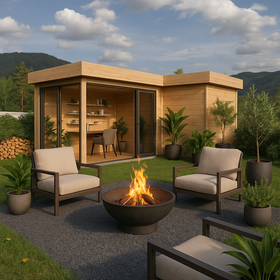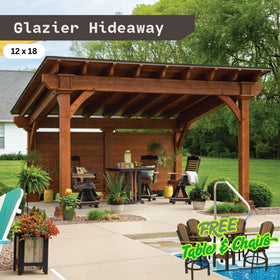512-777-0154

5 Steps to Designing a Portable Outdoor Kitchen Island
You love cooking outdoors, but dragging half your kitchen across the backyard? Not so much.
Most people want something in between a full home improvement built-in setup and the old fold-out table with paper plates. Something that works, looks good, and doesn’t require a forklift to move.
That’s where portable outdoor kitchen islands come in.
They’ve become a go-to for renters, frequent hosts, and anyone who doesn’t want to commit to a permanent structure. You can roll it out for a weekend cookout and tuck it away when you're done.
Still, designing an outdoor mobile kitchen isn’t as simple as buying a cart and calling it a day. You’ll need to consider where it goes, how it moves, what it holds, and whether it can actually meet your grilling ambitions. There’s also the small matter of not making it look like a storage shelf on wheels.
We'll break it down into five easy-to-follow steps.
Step 1: Think About Where It’s Going And How Often You’ll Move It
If you’re designing an outdoor kitchen that rolls, folds, or tucks away, you need to start with the layout. Not all spaces are built to handle carts, grills, or mini refrigerators.
Think about how you live. Do you host barbecues on the patio? Need something close to a fire pit or picnic table? Move your setup depending on the season? Store your gear in the garage when not in use?
All of that matters.
The surface you’re working with matters too. A smooth concrete slab? Great for rolling things out. Soft grass or gravel? You’re looking at wobbling, sinking, or dragging. And if your yard’s on a slope, forget wheels for now. Look for adjustable feet or leveling blocks.
Before buying or building anything, grab some masking tape or sidewalk chalk. Map out where your countertop, sink, or oven might sit. Walk around it. Check for clearance. Open fake fridge doors. It sounds basic, but it works.
Here are a few space-related questions to ask:
- Will you need access to water for a sink?
- Are there nearby outlets for an electric smoker or portable oven?
- Does the location allow for safe outdoor cooking and ventilation?
- Is it sheltered enough to avoid dragging everything back inside when it rains?
- Can you move it easily if there’s a storm coming?
- Does it need to work around a built-in fire pit or garden setup?
- Will a grill cart fit comfortably, or are you squeezing things into tight corners?
Start with the space. Everything else comes after.
Related: How to Build an Outdoor Kitchen on a Budget?
Step 2: Choose the Right Frame, Think Lightweight but Durable
Your kitchen frame is the backbone of the whole setup. It holds the weight, takes the heat, and rolls around when you need it to. But not every material is built for movement.
If you’re planning to store it in the garage, roll it across the backyard, or even shift it between garden zones, you’ll want something sturdy without being bulky. Some materials make that easier than others.
- Aluminum: Light, rust-resistant, and easy to clean. Great for a mobile setup. But it can dent if you’re rough with it.
- Stainless steel: Heavier, but more durable. Works well for built-in kitchen cabinets or islands that don’t move much.
- Powder-coated steel or recycled plastic: Solid options if you plan to keep the island in one spot. Not ideal for frequent rolling, but they’re often more budget-friendly.
- Modular or repurposed rolling carts: A smart DIY route. Add a stove or griddle on top, and you’ve got a solid outdoor cooking station without a full renovation.
If you’re tight on space, look into foldable frames. They’re not as common, but they make storage a lot easier. Just make sure the joints and hinges are strong enough to hold tools, cookware, and whatever grille or garden gear you throw at it.
And don’t skip the wheels.
Look for locking casters that can handle outdoor surfaces. You don’t want your kitchen sliding across the patio with every breeze. Especially if you're near uneven ground or keeping it close to a garden path.
Step 3: Storage and Surfaces (Keep It Minimal but Smart)
When you’re short on space, everything has to earn its spot. Outdoor cooking means juggling more than just heat and timing. You’re also dealing with tools, ingredients, gear, and that one person who always shows up early looking for snacks.
That’s where smart storage and work surfaces make a difference.
Think through the basics:
- Prepping burgers? You’ll need a stable countertop that doesn’t wobble.
- Stashing condiments, utensils, or propane? A few well-placed drawers or storage boxes go a long way.
- Hosting full-on outdoor dining? Make room for a cooler or portable gas oven without cluttering your layout.
- Drop-leaf countertops that fold down when not in use.
- Stackable bins or weatherproof cabinetry to keep things dry and organized.
- Magnetic strips for knives and hooks for grilling tools. Simple, but effective.
- Stainless steel is the easiest to clean. It holds up to heat and weather, too.
- Bamboo or wood looks sharp but needs sealing if it’s going to stay outside.
- Tile or composite offers a more permanent feel, but they’re heavier. Less ideal for a setup that moves.
A portable camp kitchen shouldn’t try to do it all. You’re not building a food truck. You’re building a compact system that gets the job done, then rolls away when you're done.
Keep it simple. Keep it clean. And don’t underestimate the value of one good drawer over five awkward ones.
Step 4: Propane, Charcoal, or Electric?
Feel choice isn’t just about taste. It affects weight, setup, and how easy it is to cook in different parts of your backyard.
Let’s keep it simple.
- Propane is the most portable-friendly option. It’s clean, easy to transport, and self-contained. You don’t need a direct gas line or a ton of prep. Just hook up the tank and start cooking. It works well with most grills, infrared burners, and even a portable propane oven. If your setup includes a gas stove or griddle, this is your best bet.
- Charcoal has that classic wood-smoke flavor. Great for smoking meat or firing up a Chicago Brick Oven 750 Gas Tailgater Wood Oven w/ Trailer. But it’s messy. You’ll need space to store the briquettes, a place to dispose of the ash, and a little patience for heat-up time. It’s also heavier. If you’re designing a kitchen that moves, this one’s harder to manage.
- Electric is the cleanest and quietest option. It’s ideal for small patios or balconies where open flame isn’t an option. Induction cookers and plug-in pizza ovens fall into this group. But you’ll need access to power. So if you're setting up far from the house, plan on using an outdoor-rated extension cord or generator.
Whichever fuel you choose, remember you’re still dealing with heat, fire, or electricity. Keep your setup clear of dry brush, overhangs, or anything that shouldn’t be near a flame. Safety first.
Step 5: Add Personality Without Losing Function
A portable deck kitchen doesn’t have to feel like a tool shed on wheels. It’s fine to add a few personal touches. A little lighting, a splash of color, maybe a few extras that make it feel more like your space. Just don’t get carried away. If it slows you down or takes up too much room, skip it.
Start with the easy stuff.
- Clip-on LED string lights or a battery lantern for evening cooking
- A chalkboard for quick menus or timers
- Reusable tins or jars for spices and dry goods
If you’ve got more space, a small cooler or a folding stool can make a big difference. Even a low-profile umbrella stand helps on hot days. Just keep it tight and easy to move.
When it comes to bigger gear, like a kamado, pizza oven, or rotisserie, ensure your base can support the weight. And leave room for things like plumbing or a small refrigerator if they’re part of your plan.
You could also add:
- A small kitchen garden in a wall-mounted box
- Neutral-colored storage bins that double as prep surfaces
- A fire pit or outdoor fireplace near your cooking station for colder nights
Style matters, but it shouldn’t get in the way. You want a portable kitchen outdoor setup that still works like a proper kitchen.

How to Make Your Portable Outdoor Kitchen Work for You
Designing a portable outdoor kitchen island isn’t about doing everything. It’s about doing the right things for your space, your style, and how you actually cook.
It should be easy to move. Simple to store. And built around what you’ll use most. Whether that’s a gas stove, an Alfresco Grills 30" Pizza Oven Plus - Countertop Model, a kegerator, or a compact prep station near the garden.
This isn’t about building a full outdoor kitchen from scratch. It’s about creating a setup that works without hiring help or tearing up your backyard.
So if you’ve been thinking about an outdoor kitchen on wheels, or want help designing a mobile outdoor kitchen that fits your life, start with the basics. Then make it your own.
You can also browse our outdoor kitchen island packages for more layout ideas, gear options, and simple backyard kitchen ideas that actually work.








